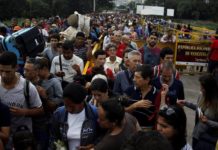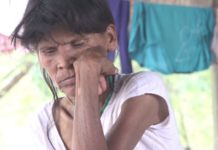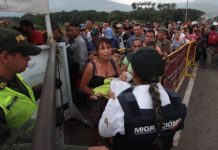‘At home, we couldn’t get by’: more Venezuelans flee as crisis deepens
Sibylla Brodzinsky in Bogotá, Dom Phillips in Rio de Janeiro, Dan Collyns in Lima and Uki Goñi in Buenos Aires
As Venezuela falls further into turmoil, more of its citizens are leaving a country that once served as a haven for economic migrants and political refugees.
There are no luxuries in the four-room house in southern Bogotá, where 12 recently arrived Venezuelans huddle on thin mattresses under even thinner blankets to ward off the Andean mountain chill. They have no hot water, and what few furnishings they have were salvaged from a nearby dump.
They work 12-hour shifts at car washes or kitchens, earning between $6.50 and $13 a day. Because most do not have work permits, they are under constant threat of deportation.
But life here is better than what they left back home in Venezuela’s Zulia state, said Paola González, 21, who arrived in Bogotá in mid-June. “At least now a day of work allows us enough to eat and even send some money back home,” she says. “In Venezuela, we couldn’t get by.”
As Venezuela falls further into a humanitarian disaster of economic collapse and political repression, more of its citizens are fleeing a country which once served as a haven for economic migrants and political refugees from around the world.
In the past, many Venezuelans headed to rich countries like US and Spain, but the latest wave of émigrés are increasingly choosing to stay in Latin America – often putting pressure social services that are unprepared to accommodate an increase of migrants.
“For the first time, Venezuela is producing rather than receiving migrants,” said Tomás Páez, a Caracas-based sociologist who in 2015 published a study on the Venezuelan diaspora in which he estimated that 7% of Venezuela’s native population of 31 million lived outside the country.
It was wealthy and professional Venezuelans who spearheaded the exodus after the late Hugo Chávez began his self-styled socialist “revolution” in 1999 – often citing rampant crime or political discontent as their reason behind leaving.
On Chavez’s death in 2013 from cancer, Nicolás Maduro was elected to succeed him as president. Since then, the situation has deteriorated dramatically, with triple-digit inflation, snaking food lines, shortages of medical supplies and vicious repression against the opposition.
The worsening conditions have left the social safety nets put in place by Chávez in tatters, and the new migrants include many poorer Venezuelans who once considered themselves Chavistas.
Only a fraction of those leaving formally seek asylum but the number of those who do is soaring. Last year, there were 27,000 Venezuelan asylum seekers worldwide. So far in 2017, more than 52,000 have applied for asylum, according to UNHCR, the UN’s refugee agency.
For many, the easiest destination to reach is Colombia, just across a porous and largely unprotected border.

Most follow well-worn paths skirting immigration controls along the 1,400 mile (2,200km) line that separates the two countries. That makes it difficult to calculate the numbers: UNHCR puts the figure at about 300,000, but the Association of Venezuelans in Colombia reckons there are about 1.2 million Venezuelans now living in the country of 45 million.
And Colombia’s government is bracing for more. It recently sent a delegation to Turkey to study that country’s experience with Syrian refugees.
Not so long ago, the countries’ fortunes were reversed: Venezuela took in millions of Colombians during the 1970s and 1980s, when Venezuela was riding an oil boom and political stability while Colombia was trapped between narco-terror and a rebel insurgency.
Today, Colombia is steadier politically and economically than its neighbour, but officials say it lacks the financial and social resources to be able to respond to large numbers of migrants.
Venezuelans are granted a special border area migration permit for 90 days but it is not valid in the rest of the country. In 2016, Colombia deported 1,956 Venezuelans – more than an eightfold increase from the year before, according to official statistics.
Though less populated than the Colombian side, Venezuela’s border with Brazil has also seen an increased number of migrants, catching authorities off guard.
At the Brazilian border state of Roraima, Telma Lage, a nun from the Centre for Migration and Human Rights, said it recently helped 290 Venezuelans with asylum applications on just one recent day.
Many are part of the Warao indigenous group, hundreds of whose members began arriving in May. The state government provided a shelter in a gymnasium in the state capital, Boa Vista, but conditions for the 400 or so people living there are rudimentary. “It is a deposit of people,” Lage said. Many of them ask for money on the streets; others find whatever odd jobs they can.
At least 500 Warao have moved on to the city of Manaus, where many camped out in the bus station until a shelter was opened to house 300 of them. On Friday, 200 were moved to five houses rented for them, said Padre Orlando Barbosa from the Manaus branch of the Catholic organization Cáritas. Another thousand non-indigenous Venezuelans are also in the city, he estimated.
In March, the Brazilian government introduced a two-year temporary residence option, but the low value of the Venezuelan currency makes the $96 it costs more than many can afford, said Maria Canineu, Brazil director of Human Rights Watch. NGOs, prosecutors and unions have asked the government to exempt Venezuelans from the cost.
“Brazil has kept its frontiers open – and this is fundamental,” said Luiz Godinho, a spokesman for UNHCR in Brasília.
In small Caribbean countries, the Venezuelans’ arrival has had a greater impact, said Charlotte Ridung, UNHCR’s senior protection adviser for the Venezuelan situation. Trinidad and Tobago, a country of 1.3 million, has received 40,000 Venezuelans. Similar situations in Panama and the Dominican Republic have reportedly led to Venezuelans being harassed and told to “go home” by local citizens.
Dominican officials have seen a surge in the number of Venezuelans arriving on direct flights from Caracas as drug mules, lured by the promise of a new life in the Caribbean country. Some critics have called on the government there to require entry visas to stem the flow.
But other countries are better prepared to receive their Bolivarian brothers. Mariella Erminy, 56, arrived in Peru in May with her pregnant daughter, son-in-law and his mother, looking for better medical care for the unborn child.
“The Peruvians have received us marvelously,” said Erminy, who worked as a lawyer in Caracas but in Lima makes a living by selling traditional Venezuelan dulcito de leche sweets.
In February, Peru introduced a special visa allowing Venezuelans already in the country to study, apply for jobs and get a bank account and access health services for up to a year. Some 6,000 Venezuelans were granted the visa and another 4,000 applicants are still awaiting approval, said Peru’s immigration superintendent, Eduardo Sevilla.
“Peru is a country which remembers,” Sevilla said, referring to the thousands of Peruvians who, fled home in the 1970s and 1980s to escape military dictatorship and economic hardship. “In the same way that Venezuela received Peruvians in the past, we will receive them too,” Sevilla said.
Argentina has also made it easy for Venezuelans to obtain a work permit, thanks in part to a similar historical gratitude toward Venezuela, and because both countries are members of South America’s Mercosur common market.
The family of Tamara Taraciuk, a senior researcher with Human Rights Watch, escaped Argentina just before the 1976 military coup. “We will always be grateful, Venezuela welcomed us with open arms,” she said.
The number of Venezuelans starting a new life in Argentina has increased exponentially since Maduro took office, from 1,911 in 2012 to 12,859 last year, according to Argentinian government statistics.
Since last year, the number of arrivals has risen by almost 250% to a total of 8,333 new Venezuelans during the first quarter of 2017, compared with a quarterly average of only 3,215 in 2016.
But new arrivals in Argentina and elsewhere usually have to settle for lower-skilled jobs than they had at home.
“I had to leave behind my profession and my optometrist’s office,” said Joel Galíndez, 26, from Maracay in north-central Venezuela, who arrived in Buenos Aires in March 2016 and now works as a sales attendant at an eyeglass shop.
“The only quality export of Venezuela’s revolution is university-trained professionals,” said María Eugenia Contreras, 32, who left Caracas in 2015 to settle in Uruguay. “I’m a lawyer with a master’s degree and my first job in Montevideo was selling Christmas decorations at a supermarket.”
As they try to make new lives in their new surroundings, Venezuelans keep close tabs on news from home mostly through WhatsApp messages and phone calls with those who stayed behind.
Galíndez, in Buenos Aires, said his girlfriend, an anesthesiologist who is still in Venezuela, is desperate. “We communicate by WhatsApp every day and what she describes is open battle,” he said. Clashes between protesters, and security forces and paramilitary militias have left more than 90 dead since March.
“About 80% of my friends are making emergency plans to leave,” said Contreras, in Montevideo.










